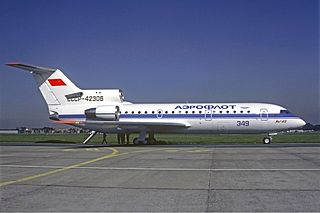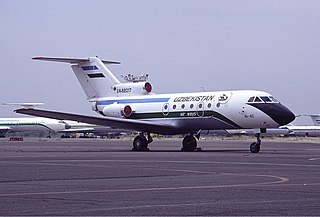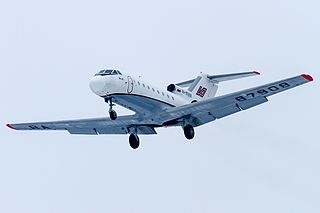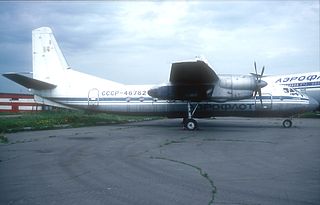Kazakhstan Airlines was an airline from Kazakhstan, serving as national flag carrier of the country from its independence in 1991 until 1996, when this role was transferred to Air Kazakhstan following the disaster of Flight 1907.

Aeroflot Flight 331 was an international passenger flight operated by an Ilyushin Il-62M that crashed about 1 km (0.62 mi) from José Martí International Airport, in Havana, Cuba, on 27 May 1977. The accident occurred after the aircraft hit power lines on its final approach to the airport during poor weather. The aircraft was attempting an emergency landing due to a fire in one of its engines. Only two of the 70 occupants on board survived. The cause of the crash was ruled to be pilot error.

Ust-Kut Airport is an airport in Irkutsk Oblast, Russia which is located 9 km north of Ust-Kut. It services short-haul routes and links the town to Irkutsk and Krasnoyarsk.

Aerosvit Flight 241 (VV241/EW241) was a scheduled international passenger flight from Kyiv's Boryspil International Airport in Ukraine to Thessaloniki International Airport in Thessaloniki, Greece with a stopover in Odessa. On 17 December 1997, the Yakovlev Yak-42 operating the flight registered as UR-42334 flew into a mountainside during a missed approach into Thessaloniki in Greece. All 70 people aboard were killed.

Berdyansk Airport is an airport in Berdyansk, Ukraine. The airport is located 1.5 km (0.93 mi) north of the city.

On 4 April 2011, a Bombardier CRJ-100 passenger jet of Georgian Airways operating a domestic flight from Kisangani to Kinshasa, Democratic Republic of Congo on behalf of United Nations, crashed while attempting to land in a thunderstorm at Kinshasa Airport. Of the 33 people on board, only one, a passenger, survived.

On 7 September 2011, Yak-Service Flight 9633, a Yakovlev Yak-42 charter flight carrying players and coaching staff of the Lokomotiv Yaroslavl professional ice hockey team, crashed on take-off near the Russian city of Yaroslavl, killing all but one of the 45 people on board. The aircraft overran the runway at Tunoshna Airport before briefly lifting off, struck an antenna mast, caught fire and crashed on the bank of the Volga river.

Aeroflot Flight 505 crashed just after takeoff in Tashkent on 16 January 1987. Flight 505 was an early morning flight from Tashkent to Shahrisabz, both in the Uzbek Soviet Socialist Republic, now the Republic of Uzbekistan. The flight took off just one minute and 28 seconds after an Ilyushin Il-76, thus encountering its wake vortex. The Yakovlev Yak-40 then banked sharply to the right, struck the ground, and caught fire. All 9 people on board died.

Aeroflot Flight 964 was a flight operated by Aeroflot from Kutaisi Airport, Georgia to Domodedovo Airport, Moscow, Russian SFSR. On 13 October 1973 the Tupolev Tu-104 operating on the route crashed during its approach to Moscow, killing all 122 passengers and crew on board. It remains the deadliest accident involving a Tupolev Tu-104.

Aeroflot Flight 8641 was a Yakovlev Yak-42 airliner on a domestic scheduled passenger flight from Leningrad to Kyiv. On 28 June 1982, the flight crashed south of Mozyr, Belorussian SSR, killing all 132 people on board. The accident was both the first and deadliest crash of a Yakovlev Yak-42, and remains the deadliest aviation accident in Belarus.

Aeroflot Flight 99 was a Tupolev Tu-124 operating a scheduled domestic passenger flight from Leningrad to Murmansk, both in the Soviet Union, which crashed while attempting to land on 11 November 1965. Of the 64 passengers and crew on board, 32 were killed in the accident, and many of the survivors sustained injuries.

Aeroflot Flight 191 was a Soviet domestic passenger flight from Vnukovo International Airport to Ashgabat International Airport, with a stopover in Turkmenbashi International Airport. On 5 March 1963, the Ilyushin Il-18 crashed while landing at Ashgabat International Airport as a result of a dust storm. 12 of the 54 people on board were killed.

Aeroflot Flight 65 was a scheduled passenger flight operated by the International Civil Aviation Directorate division of Aeroflot. On 17 February 1966 at 1:38 am local time a Tupolev Tu-114 crashed during take-off from Sheremetyevo International Airport in Moscow, killing 21 of the 47 passengers and 19 crew members on board. This was the only fatal incident involving a Tu-114. A committee investigating the accident found that the crash was due to multiple human failures.

Uzbekistan Airways Flight 1154 (HY1154/UZB1154) was a scheduled domestic passenger flight which was operated by Uzbekistan flag carrier Uzbekistan Airways from Termez Airport in the city of Termez, near the Afghanistan border, to Uzbekistan's capital of Tashkent. On 13 January 2004 the aircraft operating the flight, a Yakovlev Yak-40 registered in Uzbekistan as UK-87985, collided with a radar station while landing at Tashkent, flipped over, caught fire and exploded, killing all 37 people on board. Weather was reportedly in bad condition.

Aeroflot Flight 2415 was a regularly scheduled passenger flight from Moscow to Leningrad that crashed shortly after takeoff on 28 November 1976. The cause of the accident was attributed to crew disorientation as a result of artificial horizon failure in low visibility conditions.

The 1994 Vanavara air disaster occurred on 26 September 1994 when a Yakovlev Yak-40, operated by Russian regional airliner Cheremshanka Airlines, crashed onto the bank of a river near Vanavara, Russia. All 24 passengers and 4 crew members were killed.

Aeroflot Flight 1080 was a Soviet domestic passenger flight from Yekaterinburg, Russia, to Kostanay, Kazakhstan, that crashed at night shortly after takeoff on 7 October 1978. All 38 passengers and crew were killed in the crash which occurred when one of the engines failed due to icing during initial climb out. At the time, the crash was the second worst in the history of the Yakovlev Yak-40, which had entered operational service with Aeroflot just ten years prior.

Aeroflot Flight 36 was a scheduled domestic Aeroflot passenger flight from Chernivtsi International Airport to Kyiv International Airport (Zhuliany), Ukrainian Soviet Socialist Republic that crashed on 17 December 1976 near Kiev airport, resulting in 48 fatalities and 7 survivors.

















